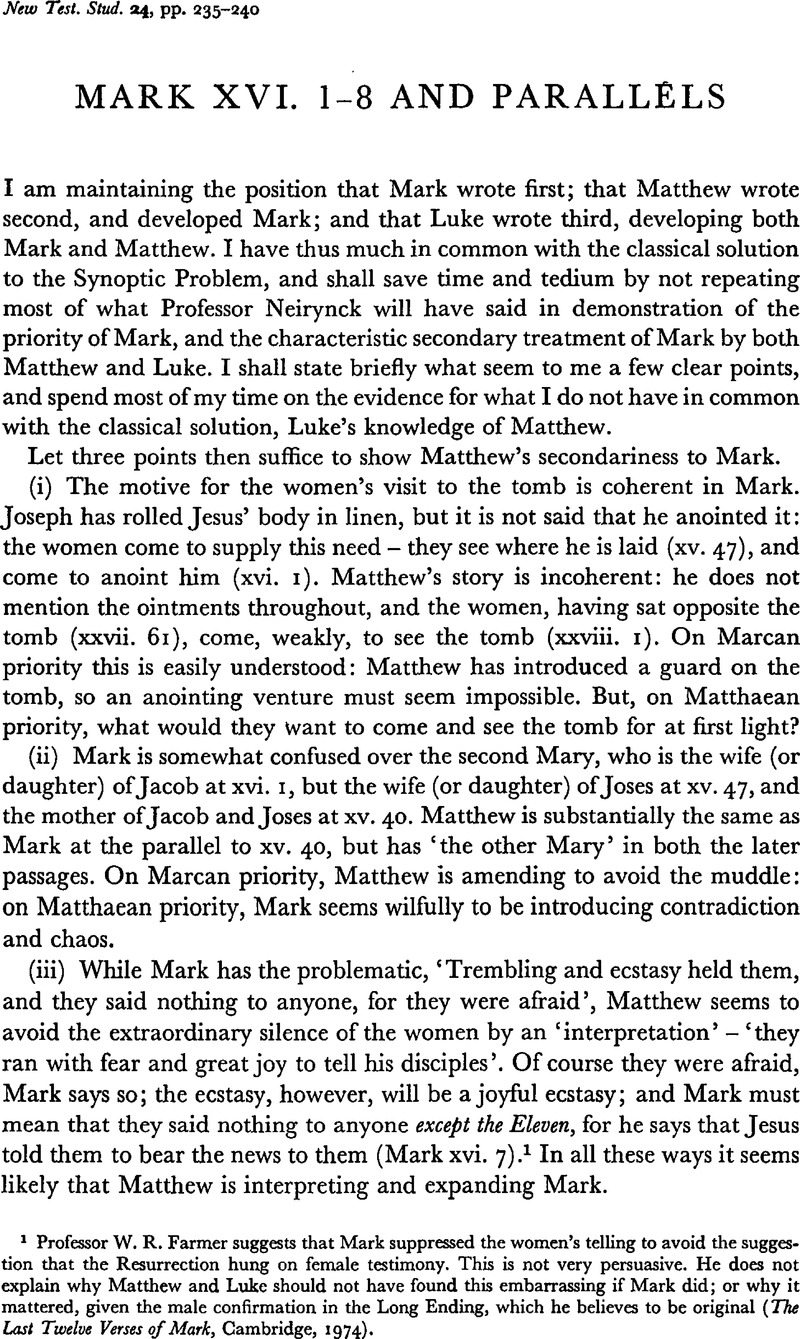No CrossRef data available.
Article contents
Mark xvi. 1–8 and Parallels
Published online by Cambridge University Press: 05 February 2009
Abstract

- Type
- Short Studies
- Information
- Copyright
- Copyright © Cambridge University Press 1978
References
page 235 note 1 Professor W. R. Farmer suggests that Mark suppressed the women's telling to avoid the suggestion that the Resurrection hung on female testimony. This is not very persuasive. He does not explain why Matthew and Luke should not have found this embarrassing if Mark did; or why it mattered, given the male confirmation in the Long Ending, which he believes to be original (The Last Twelve Verses of Mark, Cambridge, 1974).Google Scholar
page 236 note 1 There is a much fuller, perhaps complete, list in Neirynck's, F.The Minor Agreements of Matthew and Luke against Mark (Leuven, 1974), pp. 193–5Google Scholar. My point (2), which is there omitted, is not a close agreement.
page 237 note 1 The selection was made on the ground that the pericope contained so many minor agreements, and was thus a fair choice; what matters, however, is the number of inexplicable agreements claimed, and that could not be known in advance. The preceding pericope, the Burial, contains five or six: cf. my ‘On Putting Q to the Test’, above, pp. 230 f.
page 237 note 2 Bauer, W. (–Arndt–Gingrich), A Greek-English Lexicon of the NT (4th ed.Cambridge, 1952)Google Scholar, ad voc.
page 237 note 3 The prepositional use was challenged at the meeting as being ‘philologically unsound’. However, the phrases cited by Bauer are there in the texts: ![]() ψε ήλıκίας, Aelian, , V.H. 2. 23Google Scholar;
ψε ήλıκίας, Aelian, , V.H. 2. 23Google Scholar; ![]() ψε μυστηρίων, Philostratus, Vit. Apoll. 4. 18Google Scholar,
ψε μυστηρίων, Philostratus, Vit. Apoll. 4. 18Google Scholar, ![]() ψε το
ψε το![]() των, 6. 10,
των, 6. 10, ![]() ψε τ
ψε τ![]() σ μαχ
σ μαχ![]() ς, Her. 12. Aelian was writing some fifty years later than Matthew, Philostratus a century and a half later.
ς, Her. 12. Aelian was writing some fifty years later than Matthew, Philostratus a century and a half later.
page 237 note 4 J. T. S. 14 (1913), 538 ff.Google Scholar
page 238 note 1 Compare, e.g., the two ‘until’ clauses at v. 18 with different contents, or the great crowds at viii. 1 who witness the cleansing of the leper, which is imagined as being done in private (viii. 4).
page 238 note 2 He has taken the παρασκευή over from Mark, xv. 42Google Scholar, ‘Since it was Preparation, which is the day before sabbath’; and it is possible that he found support here for the women's preparing (ήτοίμασαν, and at xxiv. 1, cp. Mark's buying) the ointments. But he has still forced the meaning of Mark, xvi. 1.Google Scholar
page 239 note 1 J. T. S. 14 (1913), 188 ff.Google Scholar
page 239 note 2 See p. 237 n. 4: citation p. 546.
page 239 note 3 Jastrow, M., A Dictionary of the Targumim… (New York 1971 ed.), pp. 872 fGoogle Scholar.; q.v. for the examples following.
page 239 note 4 An Aramaic Approach to the Gospels and Acts (3rd ed.Oxford, 1967), pp. 136 ff.Google Scholar
page 240 note 1 The Four Gospels (London, 1924), p. 324.Google Scholar




